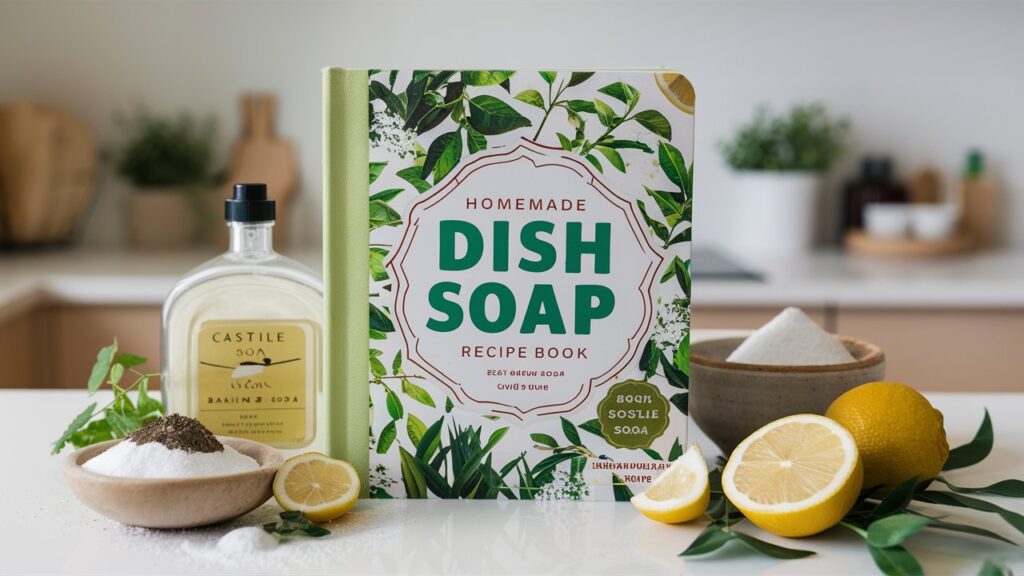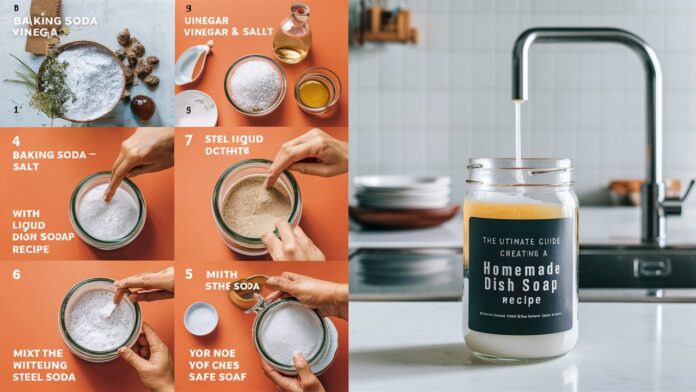Introduction to Homemade Dish Soap: Why Go Natural?
In an era where sustainability and health-conscious living are paramount, many households are ditching commercial cleaning products for homemade alternatives. Homemade dish soap recipes offer a compelling blend of eco-friendliness, cost savings, and safety, free from harsh chemicals like sulfates, phosphates, and synthetic fragrances. By crafting your own dish soap, you gain control over the ingredients, reduce plastic waste, and protect your family’s health. This article dives deep into creating a simple yet effective homemade dish soap recipe, explores its benefits, and answers common questions to ensure your transition to natural cleaning is seamless.
Benefits of Homemade Dish Soap: Eco-Friendly, Cost-Effective, and Safe
Eco-Friendly: Commercial dish soaps often contain pollutants that harm aquatic life and contribute to plastic waste. A homemade dish soap recipe uses biodegradable ingredients like Castile soap and baking soda, which break down safely in water. Reusable containers further minimize environmental impact.
Cost-Effective: A single batch of homemade dish soap costs pennies compared to store-bought options. Ingredients like Castile soap (a versatile, plant-based cleaner) and baking soda are affordable and multipurpose, stretching your household budget.
Safe for Skin and Family: Many commercial soaps contain irritants like dyes and synthetic fragrances. Homemade versions use gentle, natural ingredients, making them ideal for sensitive skin. Essential oils add fragrance without toxins, ensuring safer use around children and pets.
Essential Ingredients for a Homemade Dish Soap Recipe
A successful homemade dish soap relies on a few key ingredients:
- Liquid Castile Soap: Derived from olive oil, this plant-based soap cuts through grease and serves as the recipe’s foundation.
- Baking Soda: A mild abrasive that scrubs away food residue and neutralizes odors.
- White Vinegar: Softens water, boosts cleaning power, and dissolves mineral deposits.
- Essential Oils (e.g., Lemon, Lavender, Tea Tree): Add antibacterial properties and fresh scents.
- Warm Water: Dilutes the mixture for easy pouring.
Optional Add-Ins:
- Vegetable Glycerin for extra suds and moisturizing.
- Salt to thicken the soap.
Step-by-Step Homemade Dish Soap Recipe
Tools Needed:
- Measuring cups and spoons
- Funnel
- Reusable soap dispenser or jar
Instructions:
- Combine 1 cup of warm water and 1 tablespoon of baking soda in a bowl, stirring until dissolved.
- Add ¼ cup of liquid Castile soap and mix gently to avoid excessive foaming.
- Incorporate 1 tablespoon of white vinegar (note: this may reduce suds temporarily but enhances cleaning).
- Add 10–15 drops of essential oils for fragrance and antibacterial benefits.
- Pour the mixture into a dispenser using a funnel. Shake before each use, as natural ingredients may settle.
Storage Tip: Keep the soap in a cool, dark place to preserve its efficacy. Use within 2–3 months.
Customizing Your Homemade Dish Soap
Tailor your recipe to suit specific needs:
- For Heavy Grease: Increase Castile soap to ½ cup and add 1 teaspoon of salt for thicker consistency.
- Sensitive Skin: Use unscented Castile soap and skip essential oils.
- Antibacterial Boost: Opt for tea tree or eucalyptus oil, known for their antimicrobial properties.
- Hard Water Areas: Add an extra tablespoon of vinegar to combat mineral buildup.
Experiment with citrus peels (steeped in vinegar) or coconut oil for added shine and degreasing power.
Safety Tips and Common Mistakes to Avoid
- Avoid Mixing Castile Soap with Acidic Ingredients Directly: Always dilute vinegar in water first to prevent curdling.
- Patch Test for Sensitivities: Some essential oils may irritate skin; test on a small area before full use.
- Don’t Expect Commercial-Level Suds: Natural soaps produce fewer bubbles but clean just as effectively.
- Label Your Containers: Prevent confusion by clearly marking your homemade soap.
Frequently Asked Questions (FAQs) About Homemade Dish Soap
Q1: Will homemade dish soap work in hard water?
Yes! Adding vinegar helps soften water. For extreme hardness, increase vinegar slightly or use citric acid.
Q2: Can I use this soap in a dishwasher?
No. This recipe is designed for handwashing. Dishwashers require a different formula to prevent suds overflow.
Q3: How long does homemade dish soap last?
Up to 3 months if stored properly. Discard if the smell or texture changes.
Q4: Is it safe for septic systems?
Absolutely! Natural ingredients like Castile soap and baking soda are septic-safe.
Q5: Why does my soap feel watery?
Let the mixture sit for 24 hours; baking soda and Castile soap may thicken over time. Adjust with salt if needed.

Conclusion: Embrace a Greener Kitchen with Homemade Dish Soap
Switching to a homemade dish soap recipe is a small step with profound benefits. Not only do you reduce your exposure to harmful chemicals, but you also contribute to a healthier planet by cutting down on plastic waste. With customizable ingredients and minimal effort, this DIY solution proves that sustainable living can be simple, affordable, and effective. Give it a try—your dishes, wallet, and the environment will thank you!
Final Tip: Pair your homemade dish soap with reusable bamboo brushes or cotton cloths for a zero-waste kitchen setup!


